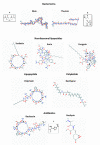Honey as an Ecological Reservoir of Antibacterial Compounds Produced by Antagonistic Microbial Interactions in Plant Nectars, Honey and Honey Bee
- PMID: 34065141
- PMCID: PMC8151657
- DOI: 10.3390/antibiotics10050551
Honey as an Ecological Reservoir of Antibacterial Compounds Produced by Antagonistic Microbial Interactions in Plant Nectars, Honey and Honey Bee
Abstract
The fundamental feature of "active honeys" is the presence and concentration of antibacterial compounds. Currently identified compounds and factors have been described in several review papers without broader interpretation or links to the processes for their formation. In this review, we indicate that the dynamic, antagonistic/competitive microbe-microbe and microbe-host interactions are the main source of antibacterial compounds in honey. The microbial colonization of nectar, bees and honey is at the center of these interactions that in consequence produce a range of defence molecules in each of these niches. The products of the microbial interference and exploitive competitions include antimicrobial peptides, antibiotics, surfactants, inhibitors of biofilm formation and quorum sensing. Their accumulation in honey by horizontal transfer might explain honey broad-spectrum, pleiotropic, antibacterial activity. We conclude that honey is an ecological reservoir of antibacterial compounds produced by antagonistic microbial interactions in plant nectars, honey and honey bee. Thus, refocusing research on secondary metabolites resulting from these microbial interactions might lead to discovery of new antibacterial compounds in honey that are target-specific, i.e., acting on specific cellular components or inhibiting the essential cellular function.
Keywords: antimicrobial compounds; bacteriocins; bee antimicrobial peptides; honey; microbiota; mode of action; pathogenesis-related proteins; siderophores; spectrum of activity; surfactants.
Conflict of interest statement
The author declares no conflict of interest.
Figures




Similar articles
-
Anti-bacterial, anti-biofilm and anti-quorum sensing activities of honey: A review.J Ethnopharmacol. 2023 Dec 5;317:116830. doi: 10.1016/j.jep.2023.116830. Epub 2023 Jul 1. J Ethnopharmacol. 2023. PMID: 37400003 Review.
-
The Antibacterial Potential of Honeydew Honey Produced by Stingless Bee (Heterotrigona itama) against Antibiotic Resistant Bacteria.Antibiotics (Basel). 2020 Dec 5;9(12):871. doi: 10.3390/antibiotics9120871. Antibiotics (Basel). 2020. PMID: 33291356 Free PMC article.
-
Structural diversity and functional variability of gut microbial communities associated with honey bees.Microb Pathog. 2020 Jan;138:103793. doi: 10.1016/j.micpath.2019.103793. Epub 2019 Oct 15. Microb Pathog. 2020. PMID: 31626917 Review.
-
Physical characteristics and antimicrobial properties of Apis mellifera, Frieseomelitta nigra and Melipona favosa bee honeys from apiaries in Trinidad and Tobago.BMC Complement Med Ther. 2020 Mar 17;20(1):85. doi: 10.1186/s12906-020-2829-5. BMC Complement Med Ther. 2020. PMID: 32178659 Free PMC article.
-
Antibacterial compounds of Canadian honeys target bacterial cell wall inducing phenotype changes, growth inhibition and cell lysis that resemble action of β-lactam antibiotics.PLoS One. 2014 Sep 5;9(9):e106967. doi: 10.1371/journal.pone.0106967. eCollection 2014. PLoS One. 2014. PMID: 25191847 Free PMC article.
Cited by
-
In Vitro Screening Potential Antibacterial Properties of the Greek Oregano Honey against Clinical Isolates of Helicobacter pylori.Foods. 2021 Jul 6;10(7):1568. doi: 10.3390/foods10071568. Foods. 2021. PMID: 34359441 Free PMC article.
-
Antimicrobial Evaluation of Various Honey Types against Carbapenemase-Producing Gram-Negative Clinical Isolates.Antibiotics (Basel). 2022 Mar 21;11(3):422. doi: 10.3390/antibiotics11030422. Antibiotics (Basel). 2022. PMID: 35326885 Free PMC article.
-
In Silico Safety Assessment of Bacillus Isolated from Polish Bee Pollen and Bee Bread as Novel Probiotic Candidates.Int J Mol Sci. 2024 Jan 4;25(1):666. doi: 10.3390/ijms25010666. Int J Mol Sci. 2024. PMID: 38203838 Free PMC article.
-
Antimicrobial Properties, Functional Characterisation and Application of Fructobacillus fructosus and Lactiplantibacillus plantarum Isolated from Artisanal Honey.Probiotics Antimicrob Proteins. 2023 Oct;15(5):1406-1423. doi: 10.1007/s12602-022-09988-4. Epub 2022 Sep 29. Probiotics Antimicrob Proteins. 2023. PMID: 36173591 Free PMC article.
-
Bee Pollen and Bee Bread as a Source of Bacteria Producing Antimicrobials.Antibiotics (Basel). 2021 Jun 13;10(6):713. doi: 10.3390/antibiotics10060713. Antibiotics (Basel). 2021. PMID: 34199247 Free PMC article.
References
-
- Molan P.C. The Antibacterial Activity of Honey. 2.Variation in the potency of the antibacterial activity. Bee World. 1992;73:59–76. doi: 10.1080/0005772X.1992.11099118. - DOI
Publication types
LinkOut - more resources
Full Text Sources
Other Literature Sources

